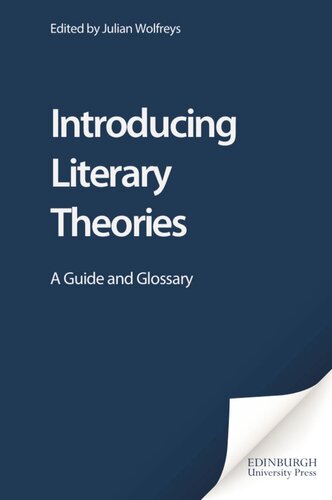

Most ebook files are in PDF format, so you can easily read them using various software such as Foxit Reader or directly on the Google Chrome browser.
Some ebook files are released by publishers in other formats such as .awz, .mobi, .epub, .fb2, etc. You may need to install specific software to read these formats on mobile/PC, such as Calibre.
Please read the tutorial at this link: https://ebookbell.com/faq
We offer FREE conversion to the popular formats you request; however, this may take some time. Therefore, right after payment, please email us, and we will try to provide the service as quickly as possible.
For some exceptional file formats or broken links (if any), please refrain from opening any disputes. Instead, email us first, and we will try to assist within a maximum of 6 hours.
EbookBell Team

4.8
34 reviewsIntroducing Literary Theories is an ideal introduction for those coming to literary theory for the first time. It provides an accessible introduction to the major theoretical approaches in chapters covering: Bakhtinian Criticism, Structuralism, Feminist Theory, Marxist Literary Theories, Reader-Response Theories, Psychoanalytic Criticism, Deconstruction, Poststructuralism, New Historicism, Cultural Materialism, Postcolonial Theory, Gay Studies/ Queer Theories, Cultural Studies and Postmodernism.
A table of contents arranged by theoretical method and a second arranged by key texts offer the reader alternative pathways through the volume and a general introduction, which traces the history and importance of literary theory, complete the introductory material.
In each of the following chapters, the authors provide a clear presentation of the theory in question and notes towards a reading of a key text to help the student understand both the methodology and the practice of literary theory. The texts used for illustration include: In Memoriam A. H. H., Middlemarch, Mrs Dalloway, Paradise Lost, A Portrait of the Artist as a Young Man, Prospero's Books, The Swimming Pool Library and The Tempest. Every chapter ends with a set of questions for further consideration, an annotated bibliography and a supplementary bibliography while a glossary of critical terms completes the book.
Derived and adapted from the successful foundation textbook, Literary Theories: A Reader and Guide, Introducing Literary Theories is a highly readable, self-contained and comprehensive guide that succeeds in making contemporary theory easily understandable.
Each chapter provides:
An overview of the theory
Notes towards readings of canonical literary texts
Questions for further consideration
An annotated bibliography
A supplementary bibliography
Key Features